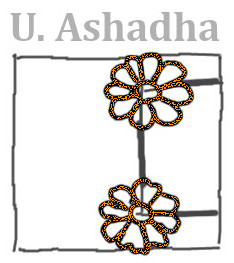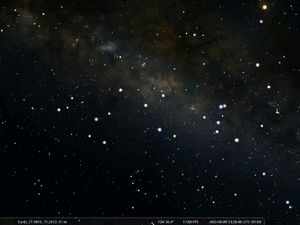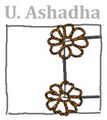Uttara Ashadha: Difference between revisions
No edit summary |
No edit summary |
||
| Line 1: | Line 1: | ||
{{DISPLAYTITLE:Uttara Āṣāḍhā (उत्तर आषाढा)}} |
{{DISPLAYTITLE:Uttara Āṣāḍhā (उत्तर आषाढा)}} |
||
[[File: |
[[File:UAshadha nakshatras in Temple draw+lbl 4ase.jpg|thumb|Uttara Ashadha, 21st nakshatra, ]] |
||
[[File:20+21 stellarium.gif|thumb|The 20th and 21st nakshatra mapped to the star chart (Stellarium). Together, these two asterisms form "The Invincible" in modern Sagittarius. Animated GIF by SMH 2025 for WGSN. Uttara A. is the latter (eastern, left here). ]] |
[[File:20+21 stellarium.gif|thumb|The 20th and 21st nakshatra mapped to the star chart (Stellarium). Together, these two asterisms form "The Invincible" in modern Sagittarius. Animated GIF by SMH 2025 for WGSN. Uttara A. is the latter (eastern, left here). ]] |
||
Uttara Āṣāḍhā (उत्तर आषाढा), The Second Invincible, is an Indian name, used by the Indian Vedic tradition. Most of these names are roughly 3000 years old. They pre-date Hinduism but were taken over by it. Typically identified with ζ and σ Sagittarii. |
Uttara Āṣāḍhā (उत्तर आषाढा), The Second Invincible, is an Indian name, used by the Indian Vedic tradition. Most of these names are roughly 3000 years old. They pre-date Hinduism but were taken over by it. Typically identified with ζ and σ Sagittarii. |
||
| Line 14: | Line 15: | ||
===Transfer and Transformation of the Constellation=== |
===Transfer and Transformation of the Constellation=== |
||
<gallery> |
|||
File:UAshadha nakshatras in Temple draw+lbl 4ase.jpg|Uttara Ashadha, |
|||
File:Nakshatra temple magDraw lbl.jpg|Display of all 28th nakshatras in silver arch with candles in Tirupperunthurai (Athmanathaswamy temple) near Aranthangi, India, 10th century CE. (SMH 2025). |
|||
File:Nakshatras in Temple draw+lbl 4ase.jpg|Display of all 28th nakshatras in a door frame in Tirupperunthurai (Athmanathaswamy temple) near Aranthangi, India, 10th century CE. (SMH 2025). |
|||
File:Tibet nakshatra 19.png|Uttara Ashada, Tibetean |
|||
File:斗宿(仏像図彙).png|Uttara Ashadha |
|||
File:21 UttaraAshadha draw.png|Uttara Ashadha, reconstructed by Jones (1720) |
|||
</gallery> |
|||
==Mythology== |
==Mythology== |
||
Revision as of 08:59, 31 October 2025
Uttara Āṣāḍhā (उत्तर आषाढा), The Second Invincible, is an Indian name, used by the Indian Vedic tradition. Most of these names are roughly 3000 years old. They pre-date Hinduism but were taken over by it. Typically identified with ζ and σ Sagittarii.
Etymology and History
Name Variants
- Uttara Ashadha
- Vaiśvadeva
Origin of Constellation
Ashadha means The Invincible and refers to two asterisms in Sagittarius. The Latter (Uttara A.) is depcted as a group of two stars that are typically taken for ζ and σ Sagittarii but they actually form part of a recognizable quadrilateral which is not really logical. Yet, the identification is certain because of given coordinates for σ Sagittarii in the 2nd millennium; whether it was a different asterism BCE, is, of course, not certain.
Transfer and Transformation of the Constellation
Mythology
mnemonic tales and cultural significance
Weblinks
References
- References (general)











